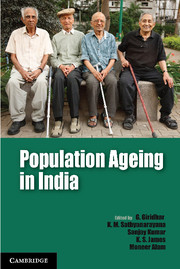Book contents
- Frontmatter
- Contents
- List of Figures
- List of Tables
- Preface
- Acknowledgements
- Introduction
- 1 Demographics of Population Ageing in India
- 2 Elderly Workforce Participation, Wage Differentials and Contribution to Household Income
- 3 Living Arrangements of Elderly in India: Policy and Programmatic Implications
- 4 Health Status of Elderly in India: Trends and Differentials
- 5 The National Policy for Older Persons: Critical Issues in Implementation
- 6 Policy Initiatives on Population Ageing in Select Asian Countries and Their Relevance to the Indian Context
- 7 Studies on Ageing in India: A Review
- Contributors
- Index
4 - Health Status of Elderly in India: Trends and Differentials
Published online by Cambridge University Press: 05 August 2014
- Frontmatter
- Contents
- List of Figures
- List of Tables
- Preface
- Acknowledgements
- Introduction
- 1 Demographics of Population Ageing in India
- 2 Elderly Workforce Participation, Wage Differentials and Contribution to Household Income
- 3 Living Arrangements of Elderly in India: Policy and Programmatic Implications
- 4 Health Status of Elderly in India: Trends and Differentials
- 5 The National Policy for Older Persons: Critical Issues in Implementation
- 6 Policy Initiatives on Population Ageing in Select Asian Countries and Their Relevance to the Indian Context
- 7 Studies on Ageing in India: A Review
- Contributors
- Index
Summary
Introduction
According to most recent age-wise population projections by the United Nations (UN) (World Population Prospects, the 2012 revision), India had a total of over 93.3 million persons in 60+ age groups by the end of the first decade of this century and became the country with the largest population of older adults in the world after China. The UN also projected that the number of India's aged would grow by about 18.96 million between 2010 and 2015, or over 3.8 per cent annually—much more than the annual average growth rate of the younger or working age cohorts (0–14 years and 15–59 years). This trend is expected to accelerate in coming decades for various socio-demographic and health reasons (Dyson, 2004; Guilmoto and Rajan, 2000; Nair and Padmadas, 1999; Visaria, 2004) and pointed to the need for understanding its various ramifications, particularly for those in the realm of health care services and their delivery mechanisms. There is considerable merit in a review of old age health and its important dimensions—including size, aetiology and socio-economic distribution of the sick and disabled (i.e. epidemiology of aging)— especially for developing policies to meet the heath care needs of the growing number of older persons. At its core, this analysis is concerned with some of these issues.
- Type
- Chapter
- Information
- Population Ageing in India , pp. 96 - 134Publisher: Cambridge University PressPrint publication year: 2014
- 1
- Cited by



